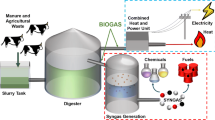Abstract
Management of coke formation during the dry reforming (DRM) and combined steam reforming (CSDRM) of methane is a crucial key towards the control of catalyst performance of such processes. Hence, this work provided a fundamental understanding of coke and coking to achieve the desire performance for the Ni-based catalysts typically employed in the industrial via the control over the formation of deactivating coke – amorphous (Cβ), carbide (Cγ), and graphitic coke (CC) that associated directly to the catalyst performance. Therefore, it is demonstrated that during DRM and CSDRM, a low reaction temperature would result in a conversion that is too low to be a practical process, while around 600 °C, the Ni carbide (Cγ) would form in high quantity, and operating up to 800 °C will cause the catalyst performance to drop significantly due high amount of graphitic coke. The CSDRM process compared to DRM can reduce the deactivating coke from 25 – 38% to 2.5 – 21.4% on the Ni-based catalysts. This positive effect on coke-resistant is the elimination of Cβ formation, which is the reactant for the graphitic carbon formation, resulting in a decrease in the overall amount of deactivating coke. Hence, we suggested that one select CSDRM over DRM due to the promotional effect of steam associated with the mitigation of the total deactivating coke via the blocking of amorphous coke formation and the appropriate temperature prevent Cγ and CC formation.












Similar content being viewed by others
References
Chen C, Wang X, Chen X, Liang X, Zou X, Lu X (2019) Combined steam and CO2 reforming of methane over one-pot prepared Ni/La-Si catalysts. Int J Hydrogen Energy 44(10):4780–4793. https://doi.org/10.1016/j.ijhydene.2019.01.019
Siang TJ, Bach LG, Singh S, Truong QD, Ho VTT, Phúc NFH, Alenazey F, VNJIJoHE VD (2019) Methane bi-reforming over boron-doped Ni/SBA-15 catalyst: longevity evaluation. Int J Hydrogen Energy 44:20839–20850
Ali S, Khader MM, Almarri MJ, Abdelmoneim AG (2020) Ni-based nano-catalysts for the dry reforming of methane. Catal Today 343:26–37. https://doi.org/10.1016/j.cattod.2019.04.066
Mallikarjun G, Sagar TV, Swapna S, Raju N, Chandrashekar P, Lingaiah N (2020) Hydrogen rich syngas production by bi-reforming of methane with CO2 over Ni supported on CeO2-SrO mixed oxide catalysts. Catal Today. https://doi.org/10.1016/j.cattod.2020.01.005
Stroud T, Smith TJ, Le Saché E, Santos JL, Centeno MA, Arellano-Garcia H, Odriozola JA, Reina TR (2018) Chemical CO2 recycling via dry and bi reforming of methane using Ni-Sn/Al2O3 and Ni-Sn/CeO2-Al2O3 catalysts. Appl Catal B 224:125–135. https://doi.org/10.1016/j.apcatb.2017.10.047
Sun J, Wang S, Guo Y, Li M, Zou H, Wang Z-j (2018) Carbon dioxide reforming of methane over nanostructured Ni/Al2O3 catalysts. Catal Commun 104:53–56. https://doi.org/10.1016/j.catcom.2017.10.021
Argyle MD, Bartholomew CH (2015) Heterogeneous catalyst deactivation and regeneration: a review. Catalysts 5(1):145–269. https://doi.org/10.3390/catal5010145
Bartholomew CH (1982) Carbon deposition in steam reforming and methanation. Catal Rev 24(1):67–112. https://doi.org/10.1080/03602458208079650
Menon PG (1990) Coke on catalysts - harmful, harmless, invisible and beneficial types. J Mol Catal 59(2):207–220. https://doi.org/10.1016/0304-5102(90)85053-K
Arora S, Prasad R (2016) An overview on dry reforming of methane: strategies to reduce carbonaceous deactivation of catalysts. Rsc Adv 6(110):108668–108688. https://doi.org/10.1039/C6RA20450C
Bereketidou OA, Goula MA (2012) Biogas reforming for syngas production over nickel supported on ceria–alumina catalysts. Catal Today 195(1):93–100. https://doi.org/10.1016/j.cattod.2012.07.006
Seo HO (2018) Recent scientific progress on developing supported Ni catalysts for dry (CO2) reforming of methane. Catalysts 8:110. https://doi.org/10.3390/catal8030110
Jabbour K, Massiani P, Davidson A, Casale S, El Hassan N (2017) Ordered mesoporous “one-pot” synthesized Ni-Mg(Ca)-Al2O3 as effective and remarkably stable catalysts for combined steam and dry reforming of methane (CSDRM). Appl Catal B 201:527–542. https://doi.org/10.1016/j.apcatb.2016.08.009
Yan X, Hu T, Liu P, Li S, Zhao B, Zhang Q, Jiao W, Chen S, Wang P, Lu J, Fan L, Deng X, Pan Y-X (2019) Highly efficient and stable Ni/CeO2-SiO2 catalyst for dry reforming of methane: effect of interfacial structure of Ni/CeO2 on SiO2. Appl Catal B 246:221–231. https://doi.org/10.1016/j.apcatb.2019.01.070
Acknowledgements
This research was financially supported by the Center of Excellence on Catalysis and Catalytic Reaction Engineering (CECC), Department of Chemical Engineering, Faculty of Engineering, Chulalongkorn University, and the Graduate School of Chulalongkorn University. The author would also like to thank partial funding from (1) the Grant for Development of New Faculty Staff, Ratchadaphiseksomphot Endowment Fund, Chulalongkorn University, (2) the Grant for Research Development, Faculty of Engineering, Chulalongkorn University, (3) the Seed Project from the Department of Chemical Engineering, Faculty of Engineering, Chulalongkorn University, Thailand and (4) the Second Century Fund (C2F), Chulalongkorn University and (5) the funding from the Malaysia-Thailand Joint Authority (MTJA).
Author information
Authors and Affiliations
Corresponding author
Additional information
Publisher's Note
Springer Nature remains neutral with regard to jurisdictional claims in published maps and institutional affiliations.
Rights and permissions
About this article
Cite this article
Buasuk, N., Saelee, T., Rittiruam, M. et al. Deactivating and Non-Deactivating Coking Found on Ni-Based Catalysts during Combined Steam-Dry Reforming of Methane. Top Catal 64, 357–370 (2021). https://doi.org/10.1007/s11244-021-01413-4
Accepted:
Published:
Issue Date:
DOI: https://doi.org/10.1007/s11244-021-01413-4




